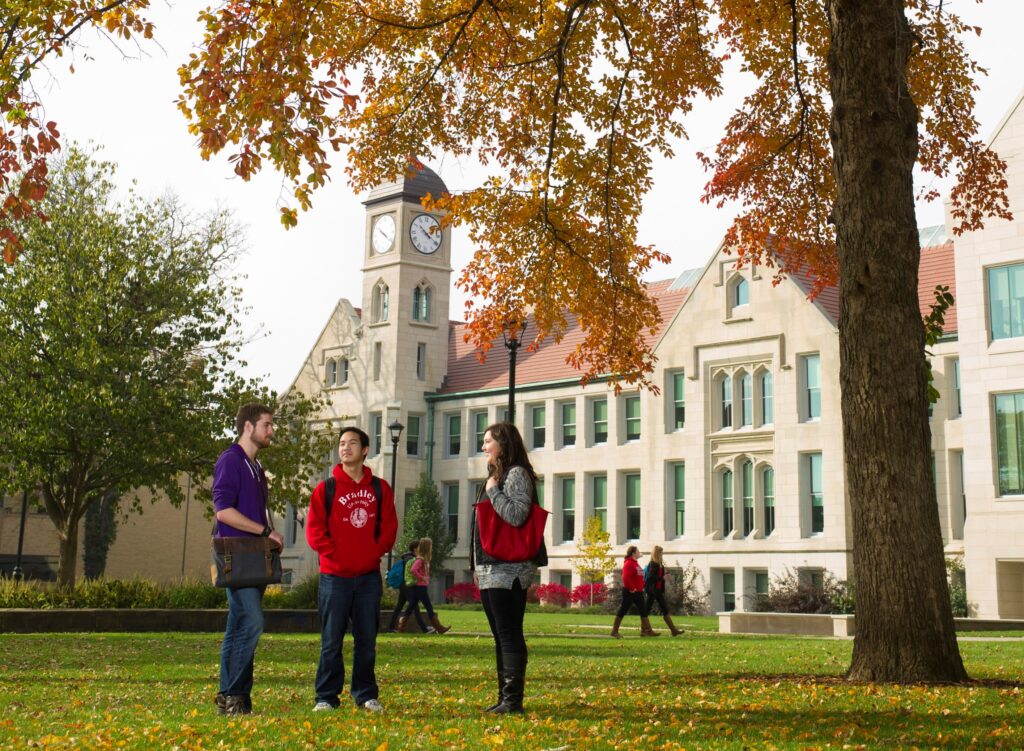As a former first-generation student who put herself through undergraduate and graduate school, Jana Hunzicker understands the value of persistence and earning credentials.

Now Associate Dean for Academic Affairs for the College of Education and Health Sciences at her alma mater, Bradley University, she believes that the right supports and connections can uplift even the most challenged students. But the path to degrees doesn’t have to be one size fits all, as long as they get there. The affirmation students get upon completion can be life changing, overcoming the chatter about affordability and return on investment in higher education.
“There is a plethora of literature that talks about how over a lifetime if you have any college degree, you’re going to have more earning power than someone without a college degree,” says Hunzicker, who oversees curriculum development and also assists with admissions and recruiting. “There are different ways to get there. It doesn’t have to be on campus, living the traditional college experience.”
It can be achieved by starting at community college, which was the track she chose. Or it can be done through short-term credentialing, or technical school. Or it can even be attained at four-year institutions like Bradley, thanks to Pell grants and other scholarships. Around a third of Bradley student receive Pell awards, and there are numerous other forms of aid available. But getting the word out about available options, especially in a hot job market, has been difficult.
“There are a lot of people who are a lot like I was: they don’t have parents who know how to guide them in going to college and they don’t have the money to go to college,” Hunzicker says. “So, they end up at community college or not going to college at all. And Bradley could be an option. There are Pell grants available. There are state grants based on financial need. I wish that we did a better job of talking to those kids that aren’t the typical, affluent top-of-their-class kids. It is a national discussion.”
More from UB: College degrees do pay off, and this university system is proof
To delve further into the topic of value and of education in general, University Business sat down for a wide-ranging conversation with Hunzicker, a dean and professor who teaches exclusively in Bradley’s Doctor of Education program. Prior to coming to the Peoria, Ill.-based university, she was both a middle school teacher and K-12 administrator.

You’ve spent much of your career in education in various roles. What does education mean to you, and especially postsecondary education, as it relates to the value of degrees?
I have always viewed education as a practical tool to build credentials and set yourself up for success, so you can not only support yourself and your family, but give back to society. Many people in higher education think of education as an opportunity to ‘expand your horizons,’ and build knowledge and appreciation of the arts and different perspectives. That’s all important. But in our college, we have a lot of degrees that lead to professional licensure. So from day one, students want to be a teacher, they want to be a nurse, they want to be a physical therapist. [They are] focused toward a career goal, as opposed to ‘I’m here to be educated and meet new people and learn new perspectives.’
Do you believe the value of degrees is still strong?
We are continuing to bring students in from all majors. To me, that indicates that students and their parents still understand the value of a college degree. Some students and parents appreciate the value of the college experience–living on campus and everything that goes along with that. Others value earning the degree.
You mentioned how transformational community college was in your life. Yet, we’ve seen enrollments falling at two-year institutions since the pandemic began. What is it that community colleges provide that still makes them so valuable?
What community colleges do is accept everyone. They give students a chance beyond maybe what they thought they could do in high school and maybe the limitations of what their family and friends and teachers thought they could do. They also make college affordable and accessible, plus make a wealth of options available. If you start off as a teacher education major and realize that’s not for you, a community college has all kinds of options, including technical trades, or short-term certificates.
What are some of the biggest challenges facing Bradley and other institutions like it?
Retention is a problem. The reason that seems to rise to the top is mental health. The isolation that students experienced was harder on them than adults realized. Also, the national demographic is changing. For a school like Bradley that for decades brought in affluent students who were academically at the top of their class, that has changed. So we’re having to look at how we keep up our enrollment. And once these students are here, how do we support them so that they can be successful? That’s been a learning curve at Bradley and at a lot of institutions.
For students who are falling through the cracks, we usually don’t realize that until they’re dropping all of their classes, or we get an exit notice that they’ve decided to leave the university. That’s something we’re really working on. How can we have mechanisms in place so that if they’re experiencing even a hint of a problem, we can help them find resources or support them or talk with them about a change of major?
What changes have you seen or are making that are geared toward keeping students engaged and succeeding long-term?
In our graduate EdD program, students have a need for synchronous meetings. We were advertising the program as completely asynchronous: You can do it in the middle of the night if you want to. But students want to have at least a little bit of interaction. So we’ve built in a lot of one-hour live sessions that are recorded. Right now, our program is set up for seven-and-a-half-week classes. But at the graduate level, there’s a lot of reading and writing, and that doesn’t give the brain time to process. So we’re going to 15-week classes. I think it’s a better model in terms of learning theory.
In graduate education, stackable credentials. People are less interested now in a full master’s degree. It’s back to this practical focus. We’re not doing a stackable model yet, but I could see that coming, where they take 12 classes that fit together into a master’s degree. It helps with the problem of delayed gratification. People don’t have to wait quite so long to get that degree. They get little rewards along the way.
Can you talk about the value of partnerships, some of the challenges and career readiness for students as they prepare to enter the workforce?
Where we have a lot of clinical experience time required as part of degree completion and state licensure, it’s important for us to have clinical sites that we can go to. In the Peoria area, we have three major hospitals, but the hospitals have their own schools of nursing. So when we need clinical time, we have to take the time that’s left over, which is often evenings and weekends. For us, having a partnership–we’re working on one right now–helps us get our foot in the door, and for hospitals, it’s providing future nurses, physician assistants or physical therapists. So I think those partnerships are becoming more important than ever.
How do you see the landscape of higher education shaping out in the next five years?
I think some institutions are going to close or be consolidated with others. We’re going to see fewer four-year institutions. Community colleges will probably be OK. Today’s students, both undergraduate and graduate, are interested in finishing a college degree sooner than the traditional four-year span. AP credit has been around forever, and dual credit is becoming more popular. Students are looking at coming into college with a semester already out of the way so that they can graduate sooner. I also think our downtime during the summer is going to go away. One model that we’ve discussed here, not with any serious tones, is the three-semester model, so that students could go to school year-round and graduate sooner. And then if they come in with dual or AP credit, they can graduate even sooner.







